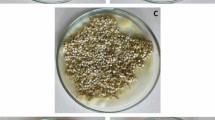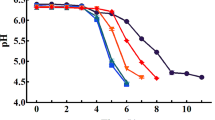Abstract
Quince (Cydonia oblonga Mill.) is a highly nutritious fruit of the sub-Himalyan regions, which has great economic and medicinal potential. Candy was developed from quince, packaged in three different packaging materials viz. polyethylene pouch, laminate, and plastic jar and was analyzed at three storage intervals (0, 60 & 120 days). With laminate showing significantly (p ≤ 0.05) higher acceptability among various packages, the overall acceptability of quince candy decreased significantly (p ≤ 0.05) during storage. Laminate showed a significant (p ≤ 0.05) protective effect on the ascorbic acid content of quince candy. Total phenolic and flavonoid contents showed a significant (p ≤ 0.05) decrease with storage time. However, laminate showed significantly (p ≤ 0.05) better retention of these components. The antioxidant properties as analyzed by DPPH radical scavenging activity, FRAP, reducing power, lipid peroxidation, and metal chelating ability decreased significantly (p ≤ 0.05) with storage time and were significantly (p ≤ 0.05) better preserved in laminate. It can be concluded that laminate is comparatively better packaging material for candies.

Similar content being viewed by others
References
AOAC (1995). Vitamin C (Ascorbic acid) in vitamin preparations and juices. 2,6-Dichloroindophenol titrimetric method. Procedure No. 967.21. In AOAC Official Methods of Analysis (pp. 1058–1059). (15th ed). Arlington, VA: Association of the Official Analytical Chemists
Aroujalian RA (2007) Reduction of the glucose syrup browning rate by the use of modified atmosphere packaging. J Food Eng 80:370–373
Benzie IFF, Strain JJ (1999) The ferric reducing ability of plasma as a measure of antioxidant power the FRAP assay. Anal Biochem 239:70–76
Bhardwaj RJ, Pandey S (2011) Juice blends-a way of utilization of under-utilized fruits, vegetables, and spices: a review. Crit Rev Food Sci Nutr 51:563–570
Brand-Williams W, Cuvelier ME, Berset C (1995) Use of free radical method to evoluate antioxidant activity. LWT-Food Sci & Techno 28:25–30
Burdurly HS, Koca N, Karadeniz F (2006) Degradation of vitamin C in citrus juice concentrates during storage. J Food Eng 74:211–216
Chandu N, Prasad M (2006) Development of guava candies. J Food Sci Technol 43:210–212
Costa AIA, Jongen WMF (2006) New insights into consumer-led food product development. Trends Food Sci Technol 17:457–465
Dar BN, Ahsan H, Wani SM, Dalal MR (2011) Effect of CaCl2, citric acid and storage period on physico-chemical characteristics of cherry candy. J Food Sci Eng 1:154–160
Del Caro A (2004) Changes of flavonoids, vitamin C and antioxidant capacity in minimally processed citrus segments and juices during storage. Food Chem 84:99–105
Devlieghere F, Debevere FJ (2003) MAP, product safety and nutritional quality. In: Ahvenainen R (ed) Book style with paper title and editor in, Novel food packaging techniques. Woodhad Publishing Limited, Cambridge, pp 208–230
Dinis TCP, Madeira VMC, Almeida LM (1994) Action of phenolic derivatives (acetaminophen, salicylate, and 5‐amino salicylate) as inhibitors of membrane lipid peroxidation and as peroxylradical scavengers. Archeol Biochem Biophys 315:161–169
Ergun R, Lietha R, Hartel RW (2010) Moisture and shelf life in sugar confections. Crit Rev Food Sci Nutr 50:162–192
FPO (2010) Guidelines for processing of fruits and vegetables. Fruit Products Order 1995. Ministry of Food Industries, Government of India, New Delhi
Gamli FO, Ibrahim H (2007) The effect of different packaging and storage conditions on the quality of ginger candy and pistachio nut paste. J Food Eng 78:443–448
Ghosh V, Duda JL, Ziegler GR, Anantheswaran RC (2004) Diffusion of moisture through chocolate-flavored confectionery. Food Biopro Proc 82:35–43
Gorinstein S, Zachwieja Z, Katrich E, Pawelzik E, Haruenkit R, Trakhtenberg S, Martin-Belloso O (2004) Comparison of the contents of the main antioxidant compounds and the antioxidant activity of white grapefruit and his new hybrid. LWT-Food Sci & Technol 37:337–343
Gupta OP (1983) Delicious candy from per fruits. Indian Hortic J 28:25–27
Ilahy R, Hdider C, Lenucci MS, Tlili I, Dalessandro G (2011) Antioxidant activity and bioactive compound changes during fruit ripening of high-lycopene tomato cultivars. J Food Compos Anal 24:588–95
Jawaheer BD, Goburdhun D, Ruggoo A (2003) Effect of processing and storage of guava into jam and juice on the Ascorbic acid content. Plant Foods Hum Nutr 58:1–12
Kaikadi MA, Chavan UD, Adsule RN (2006) Studies on preparation and shelf-life of ber candy. Bev Food World 33:49–50
Khan D, Khan AR, Bibi S, Ali S, Khalil IA (2007) Storage stability of persimmon fruits candy (Diospyros Kaki) stored in different packaging materials. Department of Food Science and Technology, NWFP Agricultural University
Klimczak I, Malecka M, Szlachta M, Gliszcynska A (2007) Effect of storage on the content of polyphenols, vitamin C and the antioxidant activity of processed foods. J Food Compos Anal 20:313–322
Kumar S, Singh IS (2001) Storage studies of aonla fruit products at ambient temperature. Progress Hortic 33:169–173
López-Rubio A, Almenar E, Hernandez-Munoz P, Lagarón JM, Catala R, Gavará R (2004) Overview of active polymer-based packaging technologies for food applications. Food Rev Inter 20:357–387
Manivasagan S, Rana GS, Kumar S, Joon MS (2006) Qualitative changes in karonda (Carissa carandas Linn.) candy during storage at room temperature. Haryana J Hortic Sci 35:19–21
Meroni A (2000) Active packaging as an opportunity to create package design that reflects the communicational functional and logistical requirements of food products. Packaging Technol Sci 13:243–248
Nawar WW (1996) Lipids. In Fennema OR, (Ed.), Food chemistry (pp. 225–313). New York: Marcel Dekker
Oktay M, Gulcin I, Kufrevioglu OI (2003) Determination of invitro antioxidant activity of Fennel seed extracts. LWT-Food Sci & Technol 36:23–271
Oliveira AP, Pereira JA, Andrade PB, Valentao P, Seabra RM, Silva BM (2007) Phenolic profile of (Cydonia oblonga Mill.) leaves. J Agric Food Chem 55:7926–7930
Polydera AC, Stoforos NG, Taoukis PS (2003) Comparative shelf life study and vitamin C loss kinetics in pasteurized and high pressure processed reconstituted orange juice. J Food Eng 60:21–23
Postman J (2008) The USDA quince and pear gene bank in Oregon, a world source of fire blight resistance. Acta Horticult 793:357–362
Prajapati ND, Purohit SS, Sharma AK, Kumar T (2003) A hand book of medicinal plants a complete source book. Agrobios, India
Ranganna S (1986) Handbook of analysis and quality control for fruit and vegetable products. Tata Mc Graw Hill Publishing Company Ltd, New Delhi, p 1112
Rooney ML (1995) Active food packaging, London, UK:Chapman amp; Hall, 1995; 272
Sakakibara H, Honda Y, Nakagawa S, Ashida H, Kanazawa K (2003) Simultaneous determination of all polyphenols in vegetables, fruits, and teas. J Agric Food Chem 51:571–581
Sellappan S, Akoh CC, Krewer G (2002) Phenolic compounds and antioxidant capacity of georgia-grown fruits and fruit products. J Agric Food Chem 50:2432–2438
Sharma SP (2000) Effect of different pricking methods and various treatments on quality of anola preserve during storage. M. Sc. Agriculture thesis, RAU, Bikaner, Rajasthan
Sharma S, Dhaliwal YS, Kalia M (1998) Candied apples: a new perspective. J Food Sci Technol 35:79–82
Silva BM, Andrade PB, Mendes GC, Seabra RM, Ferreira MA (2002) Study of the organic acid composition of quince (Cydonia oblonga Miller) fruit and jam. J Agricul Food Chem 50:2313–2317
Silva BM, Andrade PB, Mendes GC, Seabra RM, Ferreira MA (2005) Quince (Cydonia oblonga Miller) fruit characterization using principal component analysis. J Agricul Food Chem 53:111–122
Singh S (2001) Studies on bitterness development in kinnow candy, ready-to-serve, squash and jam. J Food Sci Technol 38:433–438
Singleton VL, Orthofer R, Lamuela-Raventos RM (1999) Analysis of total phenol and other oxidation substrates and antioxidants by means of Folin–Ciocalteau reagent. Methods Enzymol 299:152–178
Sogi DS, Singh S (2001) Studies on bitterness development in Kinnow juice, ready-to-serve, squash, jam and candy. J Food Sci Technol 38:433–438
Wani TA, Wani SM, Shah AG, Masoodi FA (2013) Optimizing conditions for antioxidant extraction from Sea buckthorn leaf (Hippophae rhamnoides L.) as herbal tea using response surface methodology (RSM). Int Food Res J 20:1677–1681
Wright JR, Colby HD, Miles PR (1981) Cytosolic factors which affect microsomal lipid peroxidation in lung and liver. Archeol Biochem Biophys 206:294–304
Acknowledgments
The authors are highly thankful to the Department of Biotechnology, Government of India for financial support.
Author information
Authors and Affiliations
Corresponding author
Rights and permissions
About this article
Cite this article
Mir, S.A., Wani, S.M., Ahmad, M. et al. Effect of packaging and storage on the physicochemical and antioxidant properties of quince candy. J Food Sci Technol 52, 7313–7320 (2015). https://doi.org/10.1007/s13197-015-1819-y
Revised:
Accepted:
Published:
Issue Date:
DOI: https://doi.org/10.1007/s13197-015-1819-y




